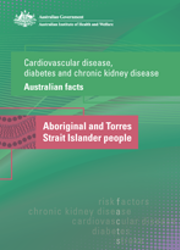Summary
This report describes the effects of three chronic diseases-cardiovascular disease (CVD) (including coronary heart disease and stroke), diabetes and chronic kidney disease (CKD)-on the Aboriginal and Torres Strait Islander population, and compares this population with the non-Indigenous population.
Higher levels of important health risk factors
In 2011-13, Indigenous adults were 2.6 times as likely as non-Indigenous adults to smoke daily (42% and 16%, respectively), 1.2 times as likely to be overweight or obese (72% and 63%), and 1.2 times as likely to have high blood pressure (25% and 21%).
Disease rates are greater, and are higher at younger ages
- In 2011-13, Indigenous adults had a higher rate of CVD than non-Indigenous adults (27% and 21%, respectively). Rates increase with age, from 9% at age 18-34 to 60% at age 65 and over.
- Indigenous adults were 3.5 times as likely as non-Indigenous adults to have diabetes (18% compared with 5%). At age 35 - 44, the rate was 4 times as high (11% compared with 3%).
- Indigenous adults were twice as likely as non-Indigenous adults to have biomedical signs of CKD (22% compared with 10%). At age 45 -54, the rate was 4 times as high (25% compared with 6%).
Hospitalisation rates are greater
- In 2013-14, Indigenous adults were almost twice as likely as non-Indigenous adults to be hospitalised with a principal diagnosis of CVD (3,149 and 1,771, respectively, per 100,000 population). More than half (52%) of Indigenous hospitalisations for CVD occurred for people aged under 55, compared with 17% for the non-Indigenous population.
- One (1) in 8 (13%) of all Indigenous hospitalisations had diabetes as a principal or additional diagnosis, compared with 9% of all non-Indigenous hospitalisations.
- CKD hospitalisations (excluding regular dialysis) were 5 times as high among Indigenous Australians as among non-Indigenous Australians (5,192 and 1,067, respectively, per 100,000 population).
Death rates are greater, and are higher at younger ages
- In 2010 -12, the Indigenous CVD mortality rate was 1.5 times as high as the non-Indigenous rate (280 and 183 deaths, respectively, per 100,000 population).
- Indigenous people were 4 times as likely as non-Indigenous people to have diabetes-and 3 times as likely to have CKD-as an underlying or associated cause of death. At age 55 - 64, death rates for both diseases were 10 times as high for Indigenous people as those for non-Indigenous people.
Disease rates rise with increasing remoteness
- In 2012-13, CVD was 1.4 times as common-and diabetes and CKD twice as common-among Indigenous people living in Remote areas compared with those in Non-remote areas.
- In Remote areas, Indigenous people were 6 times as likely to have diabetes-and 5 times as likely to have CKD-as non-Indigenous people.
Comorbidity is more frequent
- In 2011-13, 38% of Indigenous adults with CVD, diabetes or CKD had 2 or more conditions, compared with 26% of non-Indigenous adults. Comorbidity increases with age for both populations, but is greater at each age in the Indigenous population.
- The proportion of hospitalisations with all three conditions was higher for Indigenous adults (18% compared with 7%). More than one in 10 (11%) Indigenous deaths had all three conditions listed as causes of death, compared with 3% of non-Indigenous deaths.
Preface
Summary
1. Introduction
2. Risk factors
- Tobacco smoking
- Insufficient physical activity
- Excessive alcohol consumption
- Inadequate fruit and vegetable consumption
- Overweight and obesity
- High blood pressure
- Dyslipidaemia
- Impaired fasting glucose
3. Cardiovascular disease
- How many Indigenous people have cardiovascular disease?
- Hospital care for cardiovascular disease
- Cardiovascular deaths among Indigenous people
4. Diabetes
- How many Indigenous people have diabetes?
- Hospital care for diabetes
- Diabetes deaths among Indigenous people
5. Chronic kidney disease
- How many Indigenous people have chronic kidney disease?
- End-stage kidney disease
- Hospital care for chronic kidney disease
- Chronic kidney disease deaths among Indigenous people
6. Comorbidity of cardiovascular disease, diabetes and chronic kidney disease
- How many Indigenous people had cardiovascular disease, diabetes and chronic kidney disease comorbidity?
- Hospital care of comorbidities
- Multiple causes of death
End matter: Appendices; Acknowledgments; Abbreviations; Symbols; Glossary; References; List of tables; List of figures; Related publications



